Operation Management in Service Sector: Case Study and Analysis Report
VerifiedAdded on 2020/02/18
|13
|2802
|92
Report
AI Summary
This report provides a comprehensive analysis of operation management within the service sector, using a UK restaurant, Ledbury, as a case study. It begins with an executive summary, followed by an introduction defining operation management and its significance. The report then explores key concepts such as capacity planning, efficiency, resource planning, and quality management. The case study delves into the application of these concepts, including quality and inventory management, and staff motivation strategies. The report highlights the benefits of effective operation management, such as improved customer service, reduced inventory costs, and enhanced supply chain efficiency. Finally, it concludes by emphasizing the importance of strategic implementation and amendment of key concepts to increase production and meet customer demands.
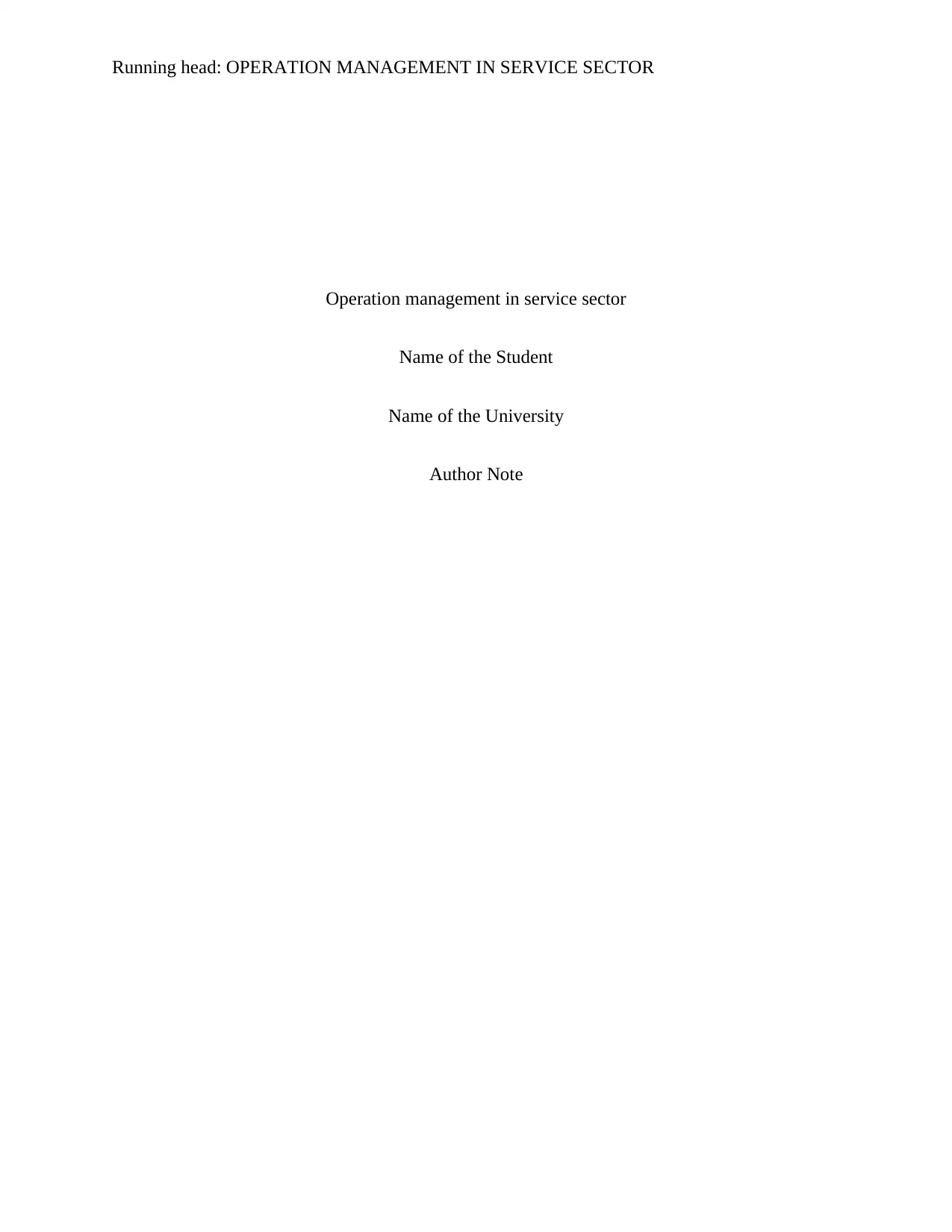
Running head: OPERATION MANAGEMENT IN SERVICE SECTOR
Operation management in service sector
Name of the Student
Name of the University
Author Note
Operation management in service sector
Name of the Student
Name of the University
Author Note
Paraphrase This Document
Need a fresh take? Get an instant paraphrase of this document with our AI Paraphraser
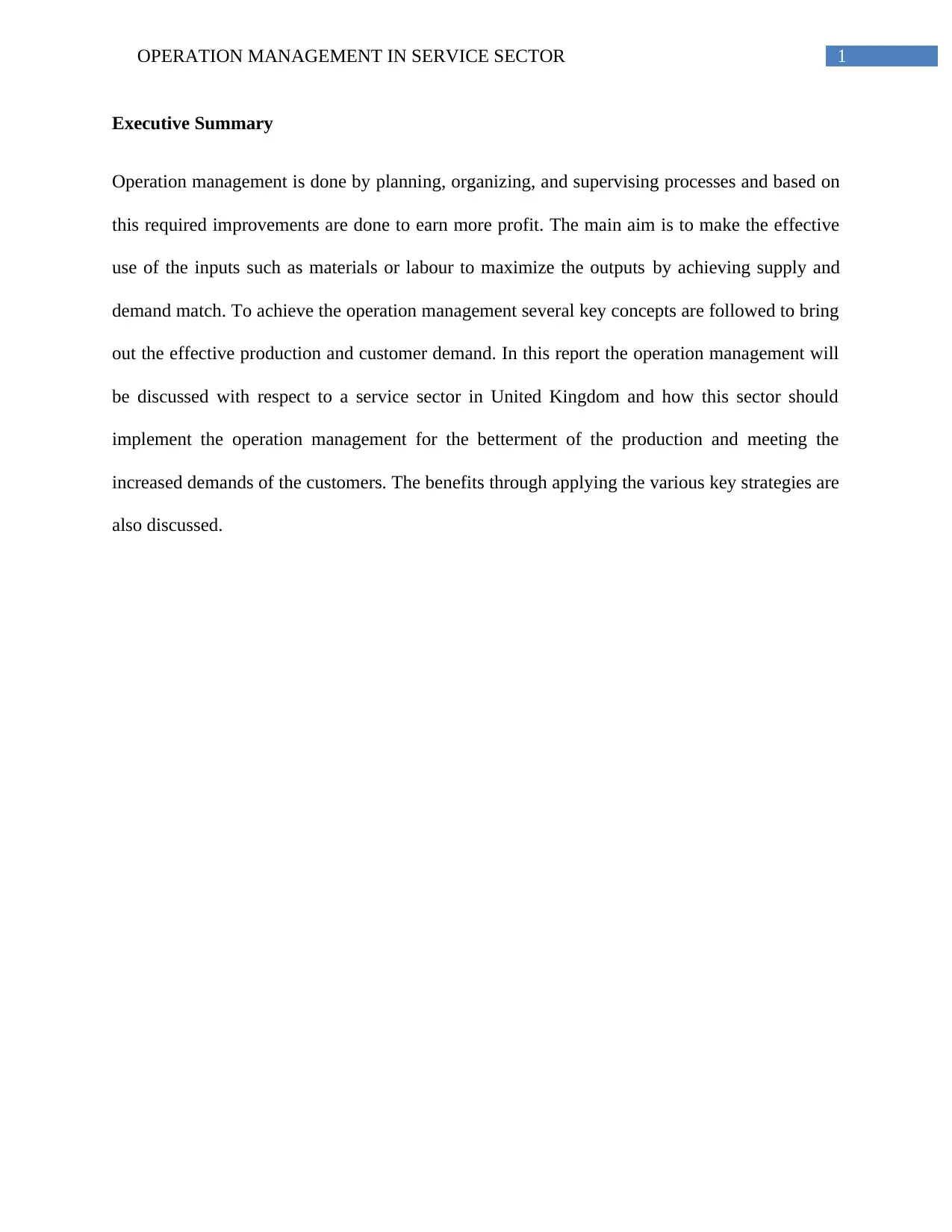
1OPERATION MANAGEMENT IN SERVICE SECTOR
Executive Summary
Operation management is done by planning, organizing, and supervising processes and based on
this required improvements are done to earn more profit. The main aim is to make the effective
use of the inputs such as materials or labour to maximize the outputs by achieving supply and
demand match. To achieve the operation management several key concepts are followed to bring
out the effective production and customer demand. In this report the operation management will
be discussed with respect to a service sector in United Kingdom and how this sector should
implement the operation management for the betterment of the production and meeting the
increased demands of the customers. The benefits through applying the various key strategies are
also discussed.
Executive Summary
Operation management is done by planning, organizing, and supervising processes and based on
this required improvements are done to earn more profit. The main aim is to make the effective
use of the inputs such as materials or labour to maximize the outputs by achieving supply and
demand match. To achieve the operation management several key concepts are followed to bring
out the effective production and customer demand. In this report the operation management will
be discussed with respect to a service sector in United Kingdom and how this sector should
implement the operation management for the betterment of the production and meeting the
increased demands of the customers. The benefits through applying the various key strategies are
also discussed.
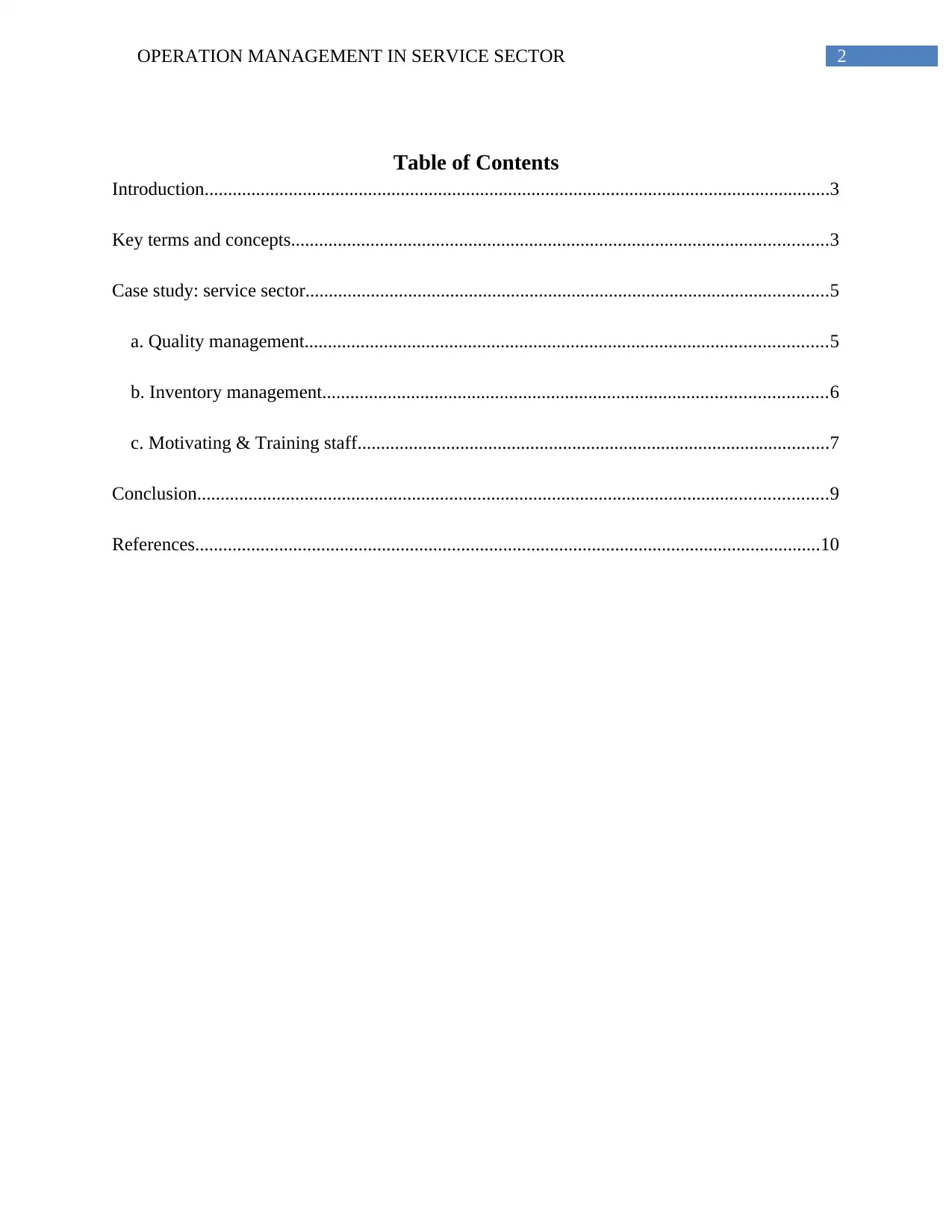
2OPERATION MANAGEMENT IN SERVICE SECTOR
Table of Contents
Introduction......................................................................................................................................3
Key terms and concepts...................................................................................................................3
Case study: service sector................................................................................................................5
a. Quality management................................................................................................................5
b. Inventory management............................................................................................................6
c. Motivating & Training staff.....................................................................................................7
Conclusion.......................................................................................................................................9
References......................................................................................................................................10
Table of Contents
Introduction......................................................................................................................................3
Key terms and concepts...................................................................................................................3
Case study: service sector................................................................................................................5
a. Quality management................................................................................................................5
b. Inventory management............................................................................................................6
c. Motivating & Training staff.....................................................................................................7
Conclusion.......................................................................................................................................9
References......................................................................................................................................10
⊘ This is a preview!⊘
Do you want full access?
Subscribe today to unlock all pages.

Trusted by 1+ million students worldwide

3OPERATION MANAGEMENT IN SERVICE SECTOR
Introduction
Operation comprises that section of organization that transforms a series of inputs to the
required output services comprising the essential quality level. The management on the other
hand is done by combining and transforming the several operational resources into value added
services based on certain policy of the organization (Brown et al. 2013). Thus the combined set
of management activities that are interrelated involved in manufacturing of certain products is
called production management whereas if the same purpose is included in service management is
known as operation management (Park Geum and Lee 2012). Operations management is done by
planning, organizing, and supervising processes and based on this required improvements are
done to earn more profit (Balwani 2012). The main aim is to make the effective use of the inputs
such as materials or labour to maximize the outputs by achieving supply and demand match
(Ellram Tate and Feitzinger 2013). The supply side functions through operating and supply
chains followed by sales and marketing in the demand part and the function of operations is to
produce products and deliver the services input and assistance from other part of organization.
Therefore, none of the business organization can survive without the interrelated combination of
supply chains and operations (Czinkota Kaufmann and Basile 2014). In this following report,
the effective operation management will be discussed with respect to a service sector taking
Ladbury restaurant in United Kingdom and the different key concepts to implement the operation
management along with the benefits will also be discussed.
Introduction
Operation comprises that section of organization that transforms a series of inputs to the
required output services comprising the essential quality level. The management on the other
hand is done by combining and transforming the several operational resources into value added
services based on certain policy of the organization (Brown et al. 2013). Thus the combined set
of management activities that are interrelated involved in manufacturing of certain products is
called production management whereas if the same purpose is included in service management is
known as operation management (Park Geum and Lee 2012). Operations management is done by
planning, organizing, and supervising processes and based on this required improvements are
done to earn more profit (Balwani 2012). The main aim is to make the effective use of the inputs
such as materials or labour to maximize the outputs by achieving supply and demand match
(Ellram Tate and Feitzinger 2013). The supply side functions through operating and supply
chains followed by sales and marketing in the demand part and the function of operations is to
produce products and deliver the services input and assistance from other part of organization.
Therefore, none of the business organization can survive without the interrelated combination of
supply chains and operations (Czinkota Kaufmann and Basile 2014). In this following report,
the effective operation management will be discussed with respect to a service sector taking
Ladbury restaurant in United Kingdom and the different key concepts to implement the operation
management along with the benefits will also be discussed.
Paraphrase This Document
Need a fresh take? Get an instant paraphrase of this document with our AI Paraphraser

4OPERATION MANAGEMENT IN SERVICE SECTOR
Key terms and concepts
The operation management works out through some strategic decisions surrounded by
some key concepts in order to make valuable decisions (Heizer 2016). All the keys for operation
management along with their terminologies are explained here.
Terms Concepts
Capacity planning To determine the production capacity in order to
meet the changing demands.
Efficiency To perform at the lowest cost
Resource planning of the sector Using sophisticated and large software systems to
coordinate the producing and delivering activities
of products
Forecasting To predict the future events including demand of
products
Just-in-time To gain production in high volume by discarding
waste with continuous improvement
Location analysis: To identify the exact location for facilitating the
service
Mass customization To customize the products and services at high
volume
Product design To decide on unique and specific factors of
products
Productivity To measure the effectiveness of converting the
inputs into outputs
Quality management To ensure the product quality by measuring and
Key terms and concepts
The operation management works out through some strategic decisions surrounded by
some key concepts in order to make valuable decisions (Heizer 2016). All the keys for operation
management along with their terminologies are explained here.
Terms Concepts
Capacity planning To determine the production capacity in order to
meet the changing demands.
Efficiency To perform at the lowest cost
Resource planning of the sector Using sophisticated and large software systems to
coordinate the producing and delivering activities
of products
Forecasting To predict the future events including demand of
products
Just-in-time To gain production in high volume by discarding
waste with continuous improvement
Location analysis: To identify the exact location for facilitating the
service
Mass customization To customize the products and services at high
volume
Product design To decide on unique and specific factors of
products
Productivity To measure the effectiveness of converting the
inputs into outputs
Quality management To ensure the product quality by measuring and
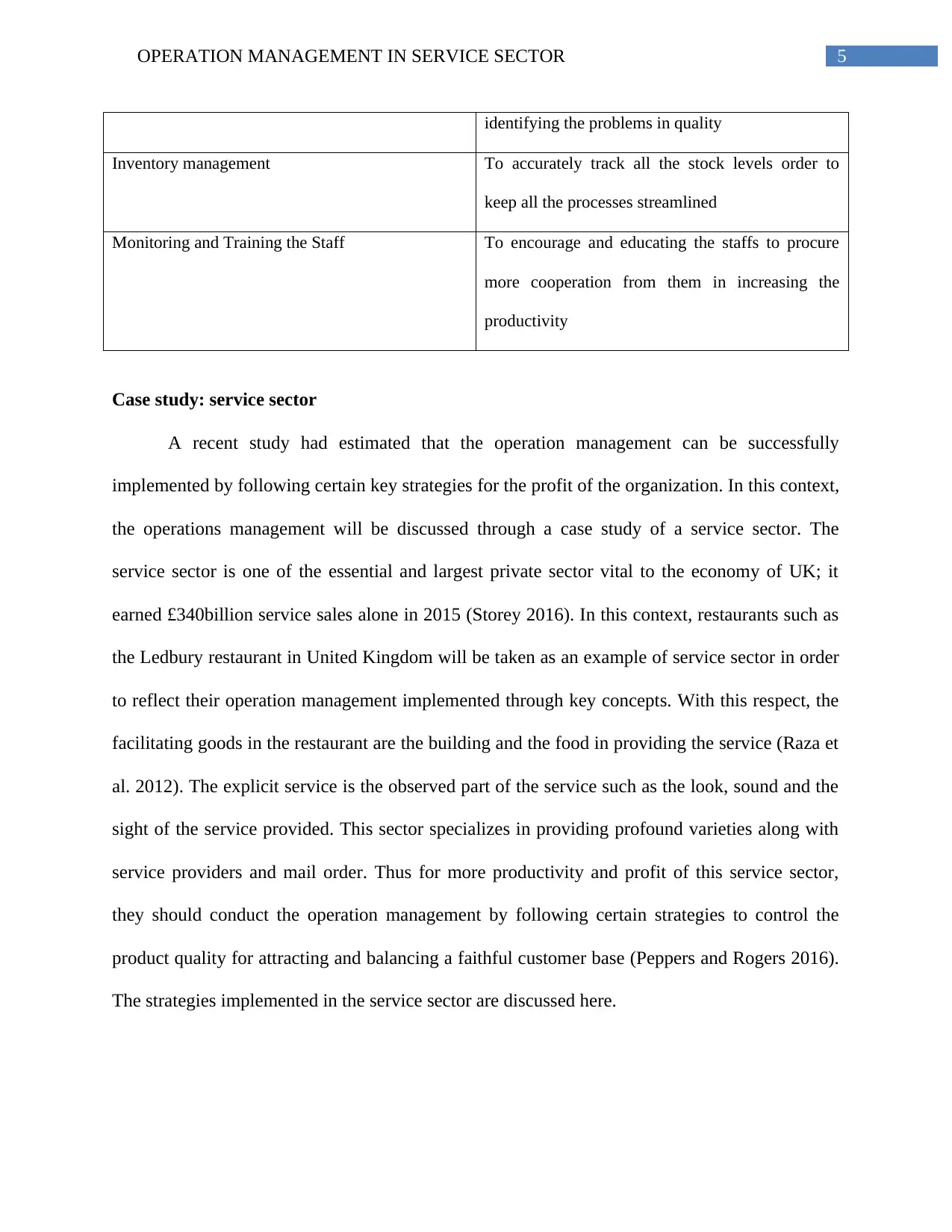
5OPERATION MANAGEMENT IN SERVICE SECTOR
identifying the problems in quality
Inventory management To accurately track all the stock levels order to
keep all the processes streamlined
Monitoring and Training the Staff To encourage and educating the staffs to procure
more cooperation from them in increasing the
productivity
Case study: service sector
A recent study had estimated that the operation management can be successfully
implemented by following certain key strategies for the profit of the organization. In this context,
the operations management will be discussed through a case study of a service sector. The
service sector is one of the essential and largest private sector vital to the economy of UK; it
earned £340billion service sales alone in 2015 (Storey 2016). In this context, restaurants such as
the Ledbury restaurant in United Kingdom will be taken as an example of service sector in order
to reflect their operation management implemented through key concepts. With this respect, the
facilitating goods in the restaurant are the building and the food in providing the service (Raza et
al. 2012). The explicit service is the observed part of the service such as the look, sound and the
sight of the service provided. This sector specializes in providing profound varieties along with
service providers and mail order. Thus for more productivity and profit of this service sector,
they should conduct the operation management by following certain strategies to control the
product quality for attracting and balancing a faithful customer base (Peppers and Rogers 2016).
The strategies implemented in the service sector are discussed here.
identifying the problems in quality
Inventory management To accurately track all the stock levels order to
keep all the processes streamlined
Monitoring and Training the Staff To encourage and educating the staffs to procure
more cooperation from them in increasing the
productivity
Case study: service sector
A recent study had estimated that the operation management can be successfully
implemented by following certain key strategies for the profit of the organization. In this context,
the operations management will be discussed through a case study of a service sector. The
service sector is one of the essential and largest private sector vital to the economy of UK; it
earned £340billion service sales alone in 2015 (Storey 2016). In this context, restaurants such as
the Ledbury restaurant in United Kingdom will be taken as an example of service sector in order
to reflect their operation management implemented through key concepts. With this respect, the
facilitating goods in the restaurant are the building and the food in providing the service (Raza et
al. 2012). The explicit service is the observed part of the service such as the look, sound and the
sight of the service provided. This sector specializes in providing profound varieties along with
service providers and mail order. Thus for more productivity and profit of this service sector,
they should conduct the operation management by following certain strategies to control the
product quality for attracting and balancing a faithful customer base (Peppers and Rogers 2016).
The strategies implemented in the service sector are discussed here.
⊘ This is a preview!⊘
Do you want full access?
Subscribe today to unlock all pages.

Trusted by 1+ million students worldwide
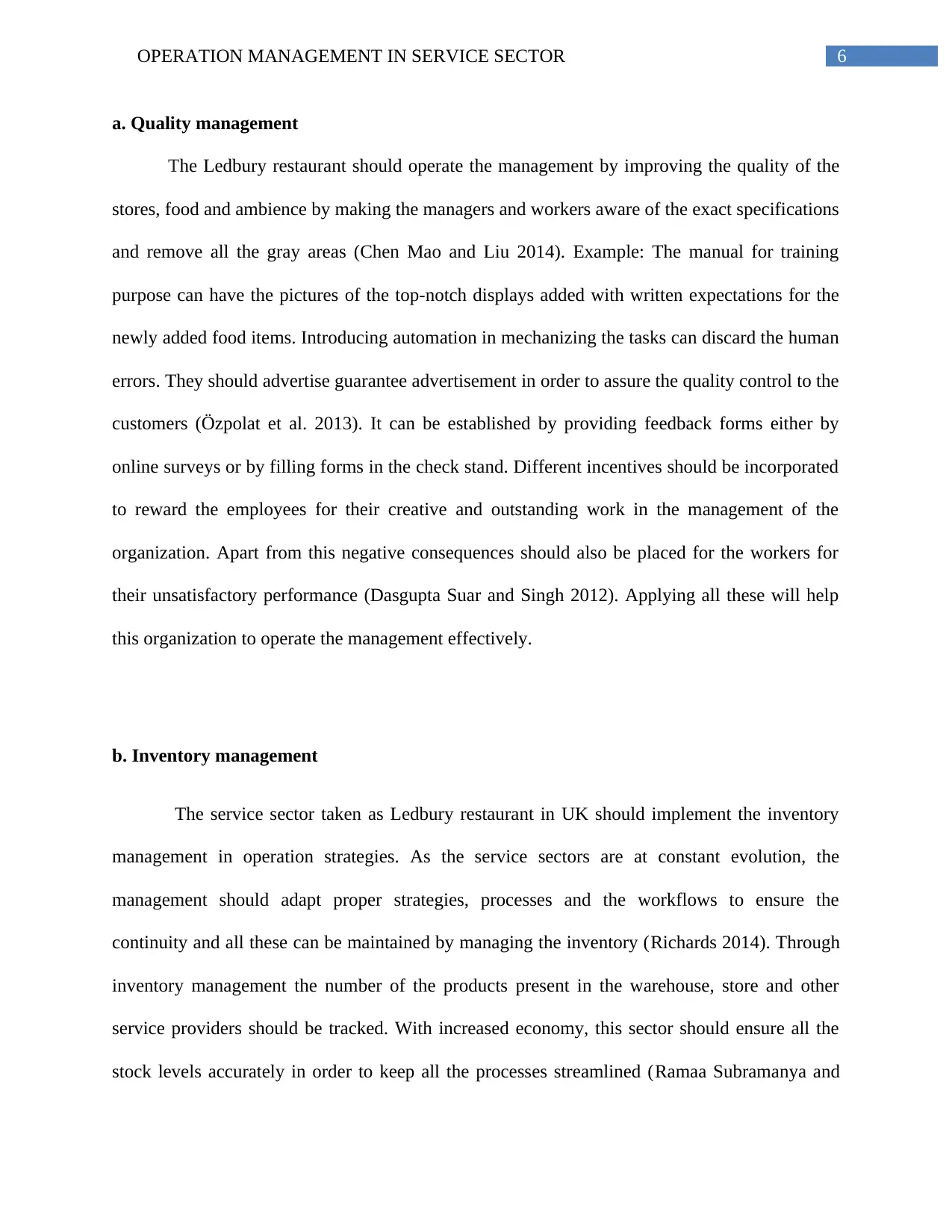
6OPERATION MANAGEMENT IN SERVICE SECTOR
a. Quality management
The Ledbury restaurant should operate the management by improving the quality of the
stores, food and ambience by making the managers and workers aware of the exact specifications
and remove all the gray areas (Chen Mao and Liu 2014). Example: The manual for training
purpose can have the pictures of the top-notch displays added with written expectations for the
newly added food items. Introducing automation in mechanizing the tasks can discard the human
errors. They should advertise guarantee advertisement in order to assure the quality control to the
customers (Özpolat et al. 2013). It can be established by providing feedback forms either by
online surveys or by filling forms in the check stand. Different incentives should be incorporated
to reward the employees for their creative and outstanding work in the management of the
organization. Apart from this negative consequences should also be placed for the workers for
their unsatisfactory performance (Dasgupta Suar and Singh 2012). Applying all these will help
this organization to operate the management effectively.
b. Inventory management
The service sector taken as Ledbury restaurant in UK should implement the inventory
management in operation strategies. As the service sectors are at constant evolution, the
management should adapt proper strategies, processes and the workflows to ensure the
continuity and all these can be maintained by managing the inventory (Richards 2014). Through
inventory management the number of the products present in the warehouse, store and other
service providers should be tracked. With increased economy, this sector should ensure all the
stock levels accurately in order to keep all the processes streamlined (Ramaa Subramanya and
a. Quality management
The Ledbury restaurant should operate the management by improving the quality of the
stores, food and ambience by making the managers and workers aware of the exact specifications
and remove all the gray areas (Chen Mao and Liu 2014). Example: The manual for training
purpose can have the pictures of the top-notch displays added with written expectations for the
newly added food items. Introducing automation in mechanizing the tasks can discard the human
errors. They should advertise guarantee advertisement in order to assure the quality control to the
customers (Özpolat et al. 2013). It can be established by providing feedback forms either by
online surveys or by filling forms in the check stand. Different incentives should be incorporated
to reward the employees for their creative and outstanding work in the management of the
organization. Apart from this negative consequences should also be placed for the workers for
their unsatisfactory performance (Dasgupta Suar and Singh 2012). Applying all these will help
this organization to operate the management effectively.
b. Inventory management
The service sector taken as Ledbury restaurant in UK should implement the inventory
management in operation strategies. As the service sectors are at constant evolution, the
management should adapt proper strategies, processes and the workflows to ensure the
continuity and all these can be maintained by managing the inventory (Richards 2014). Through
inventory management the number of the products present in the warehouse, store and other
service providers should be tracked. With increased economy, this sector should ensure all the
stock levels accurately in order to keep all the processes streamlined (Ramaa Subramanya and
Paraphrase This Document
Need a fresh take? Get an instant paraphrase of this document with our AI Paraphraser

7OPERATION MANAGEMENT IN SERVICE SECTOR
Rangaswamy 2012). They should keep track about when they are lacking the best sellers, when
to re-stock and the amount of orders to be purchased to fulfil the back orders. These tracking will
help them to satisfy the increased demands for the best orders avoiding the typing up the capital
risk in the inventory that is overstocked (Deveshwar and Modi 2013). This service organisation
should check the stock to monitor any errors in packaging, food delivery or something missing
around. Thus, knowing that the inventory levels are perfect will result in easier and rapid stock
checks (John 2012). This will handle any exceptions and allow concentrating more on the
growing activities. There will be better reviews with more sales by understocking and overselling
by making the customers happy and by updating the customers about the new stock arrival will
also encourage trusting the provider.
c. Motivating & Training staff
Apart from managing the quality and inventory, motivating and training the staffs would
also help the restaurant to increase their productivity by earning high profits. In service sector,
being a tough industry can easily demotivate the employees particularly during the holidays
resulting in slipped standards. Thus it is essential to elevate their spirits to procure the best
during the holiday rush (Maylett and Wride 2017). The Ledbury restaurant organization should
motivate the employees allocating them to meet certain challenges and providing more support
and guidance (Calabrese 2012). The employees should be given preference to work in their
preferred department and should be given responsibilities. They should nurture the recognized
rich culture my congratulating each other during their achievements openly. This would help the
employees to respect individual strength that would help the service staffs in sharing the load
(Aureli and Salvatori 2012). For example, if an employee is interested in designing displays or
Rangaswamy 2012). They should keep track about when they are lacking the best sellers, when
to re-stock and the amount of orders to be purchased to fulfil the back orders. These tracking will
help them to satisfy the increased demands for the best orders avoiding the typing up the capital
risk in the inventory that is overstocked (Deveshwar and Modi 2013). This service organisation
should check the stock to monitor any errors in packaging, food delivery or something missing
around. Thus, knowing that the inventory levels are perfect will result in easier and rapid stock
checks (John 2012). This will handle any exceptions and allow concentrating more on the
growing activities. There will be better reviews with more sales by understocking and overselling
by making the customers happy and by updating the customers about the new stock arrival will
also encourage trusting the provider.
c. Motivating & Training staff
Apart from managing the quality and inventory, motivating and training the staffs would
also help the restaurant to increase their productivity by earning high profits. In service sector,
being a tough industry can easily demotivate the employees particularly during the holidays
resulting in slipped standards. Thus it is essential to elevate their spirits to procure the best
during the holiday rush (Maylett and Wride 2017). The Ledbury restaurant organization should
motivate the employees allocating them to meet certain challenges and providing more support
and guidance (Calabrese 2012). The employees should be given preference to work in their
preferred department and should be given responsibilities. They should nurture the recognized
rich culture my congratulating each other during their achievements openly. This would help the
employees to respect individual strength that would help the service staffs in sharing the load
(Aureli and Salvatori 2012). For example, if an employee is interested in designing displays or
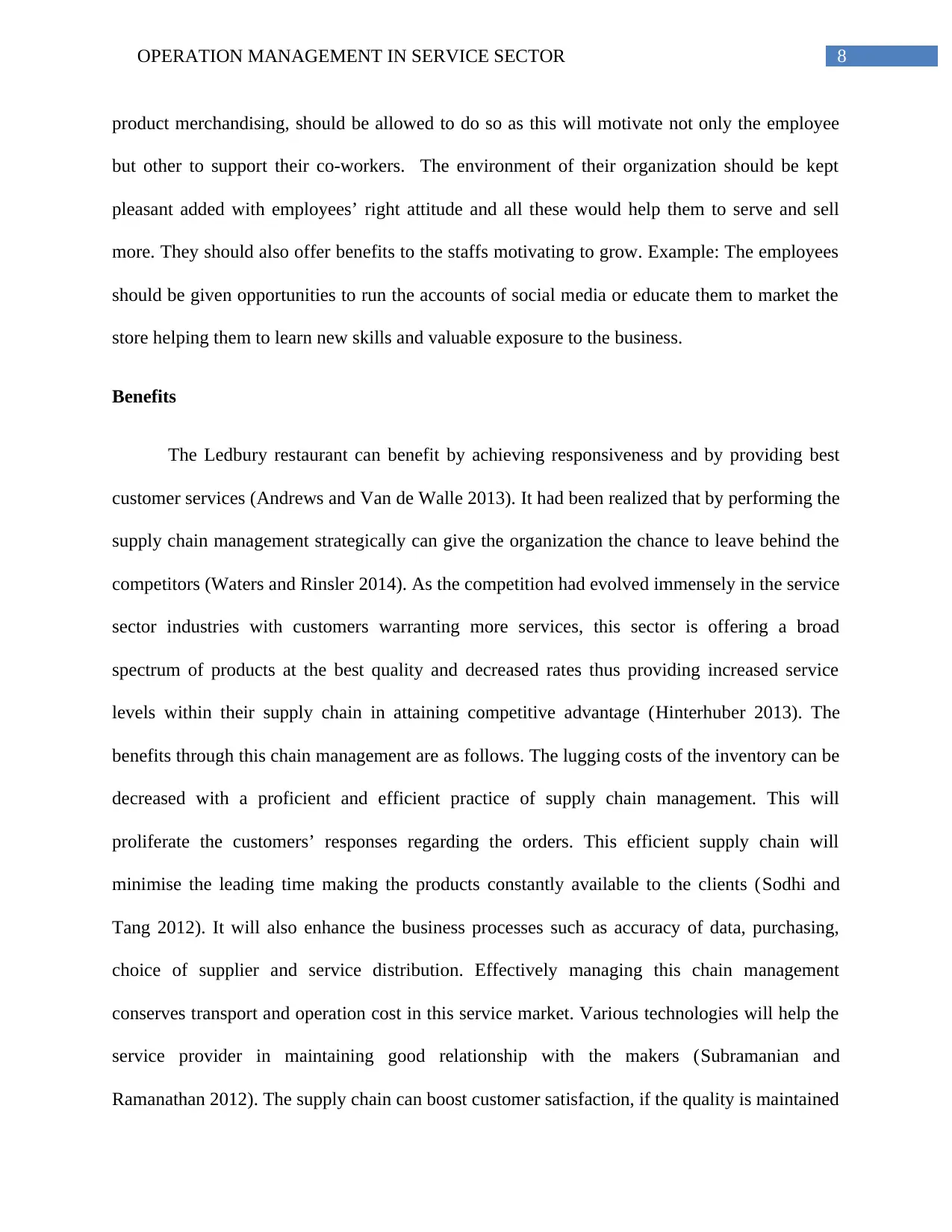
8OPERATION MANAGEMENT IN SERVICE SECTOR
product merchandising, should be allowed to do so as this will motivate not only the employee
but other to support their co-workers. The environment of their organization should be kept
pleasant added with employees’ right attitude and all these would help them to serve and sell
more. They should also offer benefits to the staffs motivating to grow. Example: The employees
should be given opportunities to run the accounts of social media or educate them to market the
store helping them to learn new skills and valuable exposure to the business.
Benefits
The Ledbury restaurant can benefit by achieving responsiveness and by providing best
customer services (Andrews and Van de Walle 2013). It had been realized that by performing the
supply chain management strategically can give the organization the chance to leave behind the
competitors (Waters and Rinsler 2014). As the competition had evolved immensely in the service
sector industries with customers warranting more services, this sector is offering a broad
spectrum of products at the best quality and decreased rates thus providing increased service
levels within their supply chain in attaining competitive advantage (Hinterhuber 2013). The
benefits through this chain management are as follows. The lugging costs of the inventory can be
decreased with a proficient and efficient practice of supply chain management. This will
proliferate the customers’ responses regarding the orders. This efficient supply chain will
minimise the leading time making the products constantly available to the clients (Sodhi and
Tang 2012). It will also enhance the business processes such as accuracy of data, purchasing,
choice of supplier and service distribution. Effectively managing this chain management
conserves transport and operation cost in this service market. Various technologies will help the
service provider in maintaining good relationship with the makers (Subramanian and
Ramanathan 2012). The supply chain can boost customer satisfaction, if the quality is maintained
product merchandising, should be allowed to do so as this will motivate not only the employee
but other to support their co-workers. The environment of their organization should be kept
pleasant added with employees’ right attitude and all these would help them to serve and sell
more. They should also offer benefits to the staffs motivating to grow. Example: The employees
should be given opportunities to run the accounts of social media or educate them to market the
store helping them to learn new skills and valuable exposure to the business.
Benefits
The Ledbury restaurant can benefit by achieving responsiveness and by providing best
customer services (Andrews and Van de Walle 2013). It had been realized that by performing the
supply chain management strategically can give the organization the chance to leave behind the
competitors (Waters and Rinsler 2014). As the competition had evolved immensely in the service
sector industries with customers warranting more services, this sector is offering a broad
spectrum of products at the best quality and decreased rates thus providing increased service
levels within their supply chain in attaining competitive advantage (Hinterhuber 2013). The
benefits through this chain management are as follows. The lugging costs of the inventory can be
decreased with a proficient and efficient practice of supply chain management. This will
proliferate the customers’ responses regarding the orders. This efficient supply chain will
minimise the leading time making the products constantly available to the clients (Sodhi and
Tang 2012). It will also enhance the business processes such as accuracy of data, purchasing,
choice of supplier and service distribution. Effectively managing this chain management
conserves transport and operation cost in this service market. Various technologies will help the
service provider in maintaining good relationship with the makers (Subramanian and
Ramanathan 2012). The supply chain can boost customer satisfaction, if the quality is maintained
⊘ This is a preview!⊘
Do you want full access?
Subscribe today to unlock all pages.

Trusted by 1+ million students worldwide

9OPERATION MANAGEMENT IN SERVICE SECTOR
throughout. The management of the supply chain benefits the service provider by providing
direct services to the clients. The service sector in turn can boost and enhance the service by
managing the upstream and downstream procedures (Gonzálvez-Gallego et al. 2013). Thus, with
effective supply chain management the Ledbury restaurant in UK can benefit largely in terms of
earning profit and customer satisfaction.
Conclusion
Thus from the above discussion it can be concluded that effective operation management
in the Ledbury restaurant in UK can be conducted by implementing and amending the key
concepts strategically. With proper operation management principles, the production of this
service sector will increase effectively by meeting the customer demands.
throughout. The management of the supply chain benefits the service provider by providing
direct services to the clients. The service sector in turn can boost and enhance the service by
managing the upstream and downstream procedures (Gonzálvez-Gallego et al. 2013). Thus, with
effective supply chain management the Ledbury restaurant in UK can benefit largely in terms of
earning profit and customer satisfaction.
Conclusion
Thus from the above discussion it can be concluded that effective operation management
in the Ledbury restaurant in UK can be conducted by implementing and amending the key
concepts strategically. With proper operation management principles, the production of this
service sector will increase effectively by meeting the customer demands.
Paraphrase This Document
Need a fresh take? Get an instant paraphrase of this document with our AI Paraphraser

10OPERATION MANAGEMENT IN SERVICE SECTOR
References
Andrews, R. and Van de Walle, S., 2013. New public management and citizens' perceptions of
local service efficiency, responsiveness, equity and effectiveness. Public Management
Review, 15(5), pp.762-783.
Aureli, S. and Salvatori, F., 2012. An investigation on possible links between risk management,
performance measurement and reward schemes. Accounting and Management Information
Systems, 11(3), p.306.
Balwani, S.S.V., 2012. Operational efficiency through resource planning optimization and work
process improvement (Doctoral dissertation, Massachusetts Institute of Technology).
Brown, S., Blackmon, K., Cousins, P. and Maylor, H., 2013. Operations management: policy,
practice and performance improvement. Routledge.
Calabrese, A., 2012. Service productivity and service quality: A necessary trade-
off?. International Journal of Production Economics, 135(2), pp.800-812.
Chen, M., Mao, S. and Liu, Y., 2014. Big data: A survey. Mobile Networks and
Applications, 19(2), pp.171-209.
Czinkota, M., Kaufmann, H.R. and Basile, G., 2014. The relationship between legitimacy,
reputation, sustainability and branding for companies and their supply chains. Industrial
Marketing Management, 43(1), pp.91-101.
Dasgupta, S.A., Suar, D. and Singh, S., 2012. Impact of managerial communication styles on
employees’ attitudes and behaviours. Employee Relations, 35(2), pp.173-199.
References
Andrews, R. and Van de Walle, S., 2013. New public management and citizens' perceptions of
local service efficiency, responsiveness, equity and effectiveness. Public Management
Review, 15(5), pp.762-783.
Aureli, S. and Salvatori, F., 2012. An investigation on possible links between risk management,
performance measurement and reward schemes. Accounting and Management Information
Systems, 11(3), p.306.
Balwani, S.S.V., 2012. Operational efficiency through resource planning optimization and work
process improvement (Doctoral dissertation, Massachusetts Institute of Technology).
Brown, S., Blackmon, K., Cousins, P. and Maylor, H., 2013. Operations management: policy,
practice and performance improvement. Routledge.
Calabrese, A., 2012. Service productivity and service quality: A necessary trade-
off?. International Journal of Production Economics, 135(2), pp.800-812.
Chen, M., Mao, S. and Liu, Y., 2014. Big data: A survey. Mobile Networks and
Applications, 19(2), pp.171-209.
Czinkota, M., Kaufmann, H.R. and Basile, G., 2014. The relationship between legitimacy,
reputation, sustainability and branding for companies and their supply chains. Industrial
Marketing Management, 43(1), pp.91-101.
Dasgupta, S.A., Suar, D. and Singh, S., 2012. Impact of managerial communication styles on
employees’ attitudes and behaviours. Employee Relations, 35(2), pp.173-199.

11OPERATION MANAGEMENT IN SERVICE SECTOR
Deveshwar, A. and Modi, D., 2013. Inventory Management Delivering Profits through Stock
Management. In 6th International Business & Social Science Research Conference.
Ellram, L.M., Tate, W.L. and Feitzinger, E.G., 2013. Factor‐market rivalry and competition for
supply chain resources. Journal of Supply Chain Management, 49(1), pp.29-46.
Gonzálvez-Gallego, N., Molina-Castillo, F.J., Soto-Acosta, P., Varajao, J. and Trigo, A., 2015.
Using integrated information systems in supply chain management. Enterprise Information
Systems, 9(2), pp.210-232.
Heizer, J., 2016. Operations Management, 11/e. Pearson Education India.
Hinterhuber, A., 2013. Can competitive advantage be predicted? Towards a predictive definition
of competitive advantage in the resource-based view of the firm. Management Decision, 51(4),
pp.795-812.
John, M., 2012. Retail Supply Chain: Challenges and Prospects.
Maylett, T. and Wride, M., 2017. The Employee Experience: How to Attract Talent, Retain Top
Performers, and Drive Results. John Wiley & Sons.
Özpolat, K., Gao, G., Jank, W. and Viswanathan, S., 2013. Research note—The value of third-
party assurance seals in online retailing: An empirical investigation. Information Systems
Research, 24(4), pp.1100-1111.
Park, Y., Geum, Y. and Lee, H., 2012. Toward integration of products and services: Taxonomy
and typology. Journal of Engineering and Technology Management, 29(4), pp.528-545.
Deveshwar, A. and Modi, D., 2013. Inventory Management Delivering Profits through Stock
Management. In 6th International Business & Social Science Research Conference.
Ellram, L.M., Tate, W.L. and Feitzinger, E.G., 2013. Factor‐market rivalry and competition for
supply chain resources. Journal of Supply Chain Management, 49(1), pp.29-46.
Gonzálvez-Gallego, N., Molina-Castillo, F.J., Soto-Acosta, P., Varajao, J. and Trigo, A., 2015.
Using integrated information systems in supply chain management. Enterprise Information
Systems, 9(2), pp.210-232.
Heizer, J., 2016. Operations Management, 11/e. Pearson Education India.
Hinterhuber, A., 2013. Can competitive advantage be predicted? Towards a predictive definition
of competitive advantage in the resource-based view of the firm. Management Decision, 51(4),
pp.795-812.
John, M., 2012. Retail Supply Chain: Challenges and Prospects.
Maylett, T. and Wride, M., 2017. The Employee Experience: How to Attract Talent, Retain Top
Performers, and Drive Results. John Wiley & Sons.
Özpolat, K., Gao, G., Jank, W. and Viswanathan, S., 2013. Research note—The value of third-
party assurance seals in online retailing: An empirical investigation. Information Systems
Research, 24(4), pp.1100-1111.
Park, Y., Geum, Y. and Lee, H., 2012. Toward integration of products and services: Taxonomy
and typology. Journal of Engineering and Technology Management, 29(4), pp.528-545.
⊘ This is a preview!⊘
Do you want full access?
Subscribe today to unlock all pages.

Trusted by 1+ million students worldwide
1 out of 13
Related Documents
Your All-in-One AI-Powered Toolkit for Academic Success.
+13062052269
info@desklib.com
Available 24*7 on WhatsApp / Email
![[object Object]](/_next/static/media/star-bottom.7253800d.svg)
Unlock your academic potential
Copyright © 2020–2025 A2Z Services. All Rights Reserved. Developed and managed by ZUCOL.





